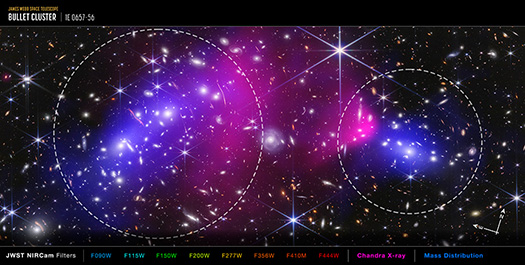New data has created a spectacular new image of the Bullet Cluster using NASA’s James Webb Space Telescope (JWST) and Chandra X-ray Observatory. The Bullet Cluster, otherwise known as 1E 0657-56, is iconic, having provided the first direct proof of dark matter through observations from Chandra, NASA’s Hubble Space Telescope and ground-based telescopes in 2006.
Now, Webb data is delivering highly detailed images that show extremely faint and distant galaxies in the cluster and the background in greater detail than ever before. Astronomers used Webb to completely map the contents of the Bullet Cluster, which gets its nickname because of its distinctive shape in X-rays. Galaxy clusters are the largest structures in the universe held together by gravity and they contain thousands of individual galaxies, huge reservoirs of superheated gas, and vast amounts of dark matter.
The new image shows the central region of the Bullet Cluster, where two of these cosmic giants are colliding with each other. The galaxies and foreground stars in the image were captured by Webb in near-infrared light (yellow and white). Meanwhile, Chandra used its X-ray vision to capture the hot gas that pervades both colliding clusters (pink) The blue represents the dark matter, which was precisely mapped by researchers with Webb’s detailed imaging. Dark matter is invisible to all telescopes since it does not emit, reflect, or absorb light. However, astronomers can map its location by studying how the light from background galaxies is warped by the gravity of material in the cluster through a process known as “gravitational lensing.”
Most of the ‘normal’ matter in galaxy clusters (that is, not dark matter) is found in hot X-ray-emitting gas with stars, dust and cooler gas in the individual galaxies making up the remainder. The rest of the mass in the Bullet Cluster is dark matter — which accounts for most of the total mass in the colliding clusters. The hot gas in each cluster was slowed by a drag force — similar to air resistance — during the collision, separating it from the dark matter and the galaxies, which were observed to pass straight through each other.
The new Webb data allows for a new and improved measurement of the thousands of galaxies in the Bullet Cluster. This means astronomers can accurately “weigh” both the visible and invisible mass in these galaxy clusters better than before.
In addition to having a more precise handle on how much mass is in the Bullet Cluster, astronomers now have an improved idea of how that mass is distributed. For example, the galaxy cluster on the left has an elongated concentration of mass along the left of the blue region, which is a clue suggesting that Bullet Cluster is the product of more than one collision billions of years ago.

The team’s findings indicate that whatever particles make up dark matter do not affect one another, other than through their mutual gravitational attraction. This lack of self-interaction implies that the particles are independent of each other, apart from their gravitational bond. Such a result may give clues about the type of particle or particles that make up dark matter. If dark matter did self-interact in Webb’s observations, the team may see a small offset between the galaxies and their respective dark matter, just as there is an offset between the hot gas and the galaxies. Webb’s observations show that dark matter still lines up with the galaxies — and was not dragged away. These new observations place stronger limits on the behavior of dark matter particles.
The new Bullet Cluster results are described in a paper that has been accepted into the Astrophysical Journal Letters, led by Ph.D. student Sanjun Cha from Yonsei University in South Korea.
The James Webb Space Telescope is the world’s premier space science observatory. Webb is solving mysteries in our solar system, looking beyond to distant worlds around other stars, and probing the mysterious structures and origins of our universe and our place in it. Webb is an international program led by NASA with its partners, ESA (European Space Agency) and CSA (Canadian Space Agency).
NASA's Marshall Space Flight Center in Huntsville, Alabama, manages the Chandra program. The Smithsonian Astrophysical Observatory's Chandra X-ray Center controls science operations from Cambridge, Massachusetts, and flight operations from Burlington, Massachusetts.
Webb near-infrared data combined with Chandra X-ray data of the Bullet Cluster show many overlapping objects, including foreground stars, galaxies in galaxy clusters, and distorted background galaxies behind the galaxy clusters. The objects are all at various distances set against the black background of space. Most galaxies appear as tiny fuzzy ovals in white, orange, or red.
A slightly larger, very bright, light blue spiral galaxy is at center. To its immediate left and right are two large bright pink splotches representing X-rays. The right pink area has a rounded nose facing right, where it is darker pink, and fades to the left as a triangular shape. This is referred to as the Bullet. To the far left and far right, next to the pink regions, are two blue regions representing dark matter mass. The left blue region is a large, long oval at an angle. The blue region at right is a far smaller oval.
|
||||||||||||||||||||||||||||


